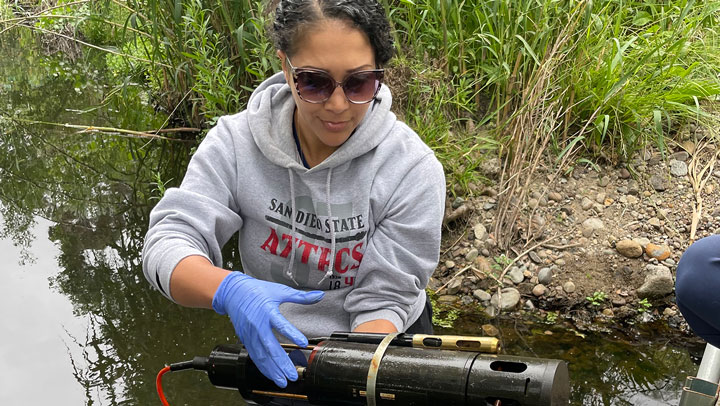University to build One Water Living Learning Laboratory at SDSU Mission Valley River Park
A $2 million grant from San Diego River Conservancy will fund a workforce training facility tackling water issues with innovative technologies.

Amid recent winter storms, ongoing contamination of local waterways, and periods of drought exacerbated by climate change, water issues have figured prominently on San Diegans’ minds lately. San Diego State University researchers have long been at the forefront of tackling these issues, and now they’ve received a $2 million grant from the San Diego River Conservancy to build a laboratory in SDSU Mission Valley’s River Park to train the region’s future water professionals and share their research with the community.
The One Water Living Learning Laboratory will allow SDSU students to deepen their understanding of watershed science and hydrological systems while gaining hands–on experience with cutting-edge technologies for studying water quality, stormwater treatment and wastewater reuse.
The planned 900 square foot facility along with outdoor space will provide a staging area for SDSU research teams conducting fieldwork and water sampling on the San Diego River as well as other nearby urban waterways.
The design of the river park includes a bioretention basin that captures and filters stormwater runoff from pavement before it returns to the San Diego River and eventually drains into the ocean. This, along with the river park’s sanitary sewer infrastructure will provide a source of stormwater and wastewater for water reuse research.
In addition, the laboratory’s location in the southwest corner of the family-friendly river park will facilitate community outreach around water issues as well as learning opportunities for K-12 students, according to Natalie Mladenov, William E. Leonhard, Jr. endowed chair and professor of environmental engineering and principal investigator of the project.
“Water issues hit home in so many ways for San Diegans,” said Mladenov. “We're going to hear more and more about extreme events like the rains and flooding that we've had. Through One Water Living Learning Lab, we want to provide a space where community members and students can have a chance to interact with different technologies and better understand the value that water has."
All water is valuable
According to Mladenov, people used to think about rivers, drinking water and wastewater as separate entities. But the “one water” concept at the heart of the new laboratory’s vision treats all water as an important resource.
“It's not just water from the Colorado River that we need to be using, especially in this water scarce environment where we live,” she said. “We have the technologies to treat all water types — including wastewater or stormwater that runs off from the landscape — to make it clean water that's safe enough for drinking. And it's all connected. Safely treating the water means that we can protect the water quality of our rivers so that we can enjoy them and maintain public health.”
Technologies that go beyond just eliminating harmful microbes and toxins will also be showcased at the lab, such as those that remove microplastics and “forever chemicals,” or PFAS, from stormwater and river water, harvest rainwater, or treat greywater from showers and sinks in the home.
“We also would love to demonstrate technologies that became popular during Covid where we can monitor wastewater for outbreaks,” said Mladenov.
Mladenov said wastewater also harbors valuable resources that are often overlooked, such as nutrients, precious metals, and even energy. Visitors to the laboratory will have the opportunity to learn about technologies for recovering these resources while reducing greenhouse gases and addressing climate change at the same time.
In addition to Mladenov, other faculty members from the Department of Civil, Construction, and Environmental Engineering whose research groups are involved in the development of the One Water Living Learning Laboratory include professor and chair Dongye Zhao, associate professor Alicia Kinoshita, associate professor Matthew Verbyla, and assistant professor Christy Dykstra, with support from other members of SDSU’s Blue Gold Area of Excellence Initiative.
“Water is so central to our daily lives that it can be easy to take for granted the amount of human effort and ingenuity required to ensure a safe drinking water supply, prevent flooding, and protect our waterways,” said SDSU Vice President for Research and Innovation Hala Madanat. “As one of SDSU Mission Valley’s first active research and training facilities, the construction of One Water Living Learning Laboratory reflects SDSU’s commitment to preparing the workforce with the skills that will be required to navigate the region’s water challenges in the future.”
“It is vital to collaborate on issues relating to water quality and supply, hydrology, flood control, water reuse, and local watersheds in San Diego County,” said Julia L. Richards, executive officer of San Diego River Conservancy. “This initiative will undoubtedly set a new standard for innovation and excellence in the field of water resource management. We are excited to continue working closely with San Diego State University to develop and implement forward-thinking projects to positively impact the San Diego region.”
The One Water Living Learning Laboratory is scheduled to open in January 2026.



